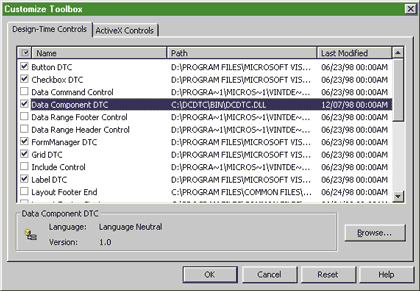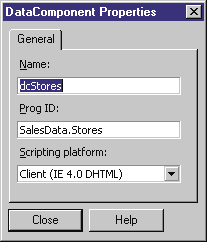![]()
|
This article may contain URLs that were valid when originally published, but now link to sites or pages that no longer exist. To maintain the flow of the article, we've left these URLs in the text, but disabled the links.
|

| Ken Spencer |
| The Data Component DTC |
Since the DC DTC works like the Recordset DTC, it can serve as a data source in your ASP code. This lets you bind other design-time controls directly to a DC DTC. You can also implement the DC DTC in either ASP or DHTML. Whether you implement the DC DTC in ASP or as DHTML on the client, the data component object linked to the DC DTC runs on the server. So what is a data component that can be used with the DC design-time control? The data component is a standard COM component that includes methods returning an ADO recordset. You can build the component in any language that supports COM and allows you to return ADO recordsets, such as Visual Basic® or Visual C++®. You create the component so that certain methods return ADO recordsets as their return values. The recordsets are then passed to the DC DTC. More on this in a moment. To perform updates, additions, deletions, and other similar operations, the DC DTC merely serves as a middle layer to your object's methods. When you create ASP applications using the DC DTC, the DC DTC simply executes methods in the object assigned to it to perform actions such as an insert or update. This ability will enable you to use existing objects with just a bit of tweaking. To take a look at this new design-time control, let's walk through its sample Sales demo files. This sample is interesting in that it implements the DC DTC in DHTML. Before you can use the DC DTC, you must install it onto your system. There are also several files that must be copied to the _ScriptLibrary directory in every project in which you will use the DC DTC. These files implement the runtime code. Note that all of my work with the DC DTC has been on beta versions, so there may be some differences in the release version you can now download. Check the readme files and documentation provided with the release software for additional information. After you have installed the DC DTC, you can use it in your applications by adding it to pages from the Toolbox. If the DC DTC does not show up in the Toolbox, add it by right-clicking the Toolbox and selecting Customize Toolbox. Next, select the checkbox to the left of the component in the Customize Toolbox dialog (see Figure 1). If the DC DTC does not show up in the Toolbox or the Customize Toolbox dialog, there is a problem with the installation and you should reinstall the DC DTC. |
 |
| Figure 1: Adding the DC DTC to Your Apps |
To use the DC DTC with a new page, drag it from the Toolbox and drop it on a page just like you would a Recordset design-time control, then open the DC DTC properties. Figure 2 shows the properties for dcStores. First, change the name of the DC DTC. Next, specify the ProgID of the object the DC DTC links to by specifying the object's ProgID. The ProgID is created when you create the object in a language like Visual Basic. For a Visual Basic-based component, the first part of the ProgID is the project's name and the second part is the object (class) name. Finally, select the scripting model. The sample implements the DC DTCs on the client using DHTML.
 |
| Figure 2: dcStores Properties |
Using the Data Component to Return Recordsets
You should not use special characters such as !, @, #, $, %, ^, &, *, (, and ) in your field or database names. I learned long ago that it's best to stick with standard characters and naming conventions for database, table, and column names. Microsoft® Access may allow special characters in a name. You can use spaces in table and column names in Microsoft Access databases. However, these databases must be modified when moved to SQL Server™ because SQL Server does not allow spaces in names. The same thing applies for Windows NT® Server and user names—and almost any type of name for an application or a system. Some allow special characters in names, while others do not. Stick with standard alphanumeric characters and you are almost always ok.
To use the DC DTC to retrieve data, your object must support a method that returns an ADO recordset. The Visual Basic code shown in Figure 3 has several methods in the Sales class that perform the functions used by the DC DTC in the Sales.asp code.
Let's look at one of the methods that returns a recordset. The topTitlesbyStore method retrieves titles by store (using store_id). This method calls the getRecordset function, which performs all the ADO work. The getRecordset function returns the resulting recordset to the topTitlesbyStore method, which stores it in the rsTable1 variable. The code then sets the return value of the topTitlesbyStore method to the recordset using this statement:
Set topTitlesbyStore = rsTable1
Function dcStores_ongetrecordsource()
if not IsEmpty(dcStores.getParameter(0)) then
dcStores.source.StateFilter = dcStores.getParameter(0)
end if
set dcStores_ongetrecordsource = dcStores.source.getStores()
End Function
dcStores.setParameter(0,lbStates.getValue(lbStates.selectedIndex));
dcStores.requery();
Performing Other Actions
The DC DTC also allows you to perform actions such as updates and inserts in the recordset. This part of the code is quite simple; the object's methods can be standard methods that take parameters and perform actions using ADO or any other type of data access, even performing nontraditional actions such as sending email, using Microsoft Message Queuing, or writing to files.
Take a look at the updStore method in Figure 3. This method takes a series of parameters, then constructs a recordset and finds the store to update in the recordset. This is no different than a method in any business object or even a two-tier application that updates data in a database. You can use stored procedures, SQL, or any other method to perform the update action—the DC DTC does not care or even know. This is one of the advantages of using the DC DTC to link with the middle-tier object; the object becomes a true black box and you do not need to understand how the
object works, only that the object provides access to the
data you need. The DC DTC and the object take care of the marshaling and implementation, in addition to data access.
To perform update, insert, or delete actions in your ASP or DHTML code, you can use one of the following DC DTC events to execute the method in the object:
|
In Sales.asp, each event handler simply takes the values from the user input and feeds them to the corresponding method of the object as parameters. The following ASP code example implements the event handler for an insert action to the recordset:
Function dcStores_oninsert() _
dcStores.source.newStore dcStores.fields.getValue(0), _
dcStores.fields.getValue(1), _
dcStores.fields.getValue(2), _
dcStores.fields.getValue(3), _
dcStores.fields.getValue(4), _
dcStores.fields.getValue(5)
End Function
function btInsert_onclick() {
dcStores.addRecord();
}
function btUpdate_onclick() {
dcStores.updateRecord();
}
Function dcStores_onupdate()
dcStores.source.updStore _
dcStores.fields.getValue(0), _
dcStores.fields.getValue(1), _
dcStores.fields.getValue(2), _
dcStores.fields.getValue(3), _
dcStores.fields.getValue(4), _
dcStores.fields.getValue(5)
End Function
Conclusion
There are a number of other DC DTC methods you can use. As I mentioned earlier, the DC DTC implements most or all (I haven't counted them) of the Recordset DTC object's events, methods, and properties. The Source child object also gives you direct access to the methods and properties of the middle-tier object to which the DC DTC links.
In a development environment where you are working on one workstation and the application is running on another workstation, you should install the middle-tier component on both the production server and the developer workstations. This will allow you to use and test the application locally on the workstation and run and test the application on the server. If the component is only registered on the server, then you can't test the
application on the workstation unless you use DCOM to access the component.
Also, by registering the component on the workstation, you can take advantage of IntelliSense® statement completion when you use the Source child object. To register the component locally, you don't need to copy the component to your workstation, you only need access to the component across your LAN. This lets you keep one copy of the component on the server and access it from both your workstation and the server as if it is a local component in both places.
From the April 1999 issue of Microsoft Internet Developer.